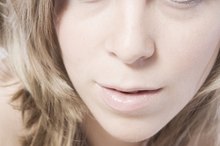How to Stop the Itch of Folliculitis
When hair follicles are damaged by friction from clothing or blocked by skin cells, the result can be folliculitis, a bacterial infection 13. Itching, redness and the appearance of white, pus-filled bumps are symptoms of folliculitis 13. The condition can occur on nearly any part of the body, with the face, scalp, thighs and groin among the most likely locations. Simple self-care steps can help alleviate itching and inflammation, but persistent or severe folliculitis may require medical treatment 13.
Rub the affected area with an antibacterial soap and a warm, wet washcloth. If folliculitis affects the skin under a beard or on the scalp, use a shampoo made with selenium in place of the antibacterial soap 13. Rub the area for 15 to 20 seconds. This effort can help kill excess bacteria and encourage fluids to drain from the follicle.
What Is the Difference Between Cellulitis & Mrsa?
Learn More
Rinse the skin and washcloth with warm water. Place the warm cloth over the skin until it cools.
Mix 1 part white vinegar with 4 parts warm water. Soak a clean washcloth in the solution. Apply the cloth to the affected area for five to 10 minutes.
What Is the Difference Between Cellulitis & Mrsa?
Learn More
Rinse the skin and pat dry.
Apply a thin layer of hydrocortisone cream to the area to diminish inflammation and reduce itching.
Tips
Discard and disinfect any objects that have been used on the affected area, such as a razor.
Apply an over-the-counter antifungal cream to the area in place of hydrocortisone cream if the infection doesn't appear to be improving after two days of treatment.
Related Articles
References
- Cigna: Folliculitis
- National Institutes of Health: Folliculitis
- MayoClinic.com: Folliculitis
- American Academy of Dermatology Association. Acne-like breakouts could be folliculitis.
- U.S. National Library of Medicine. MedlinePlus. Folliculitis. Reviewed October 8, 2018.
- Merck Manual Professional Version. Folliculitis, Revised September 2019.
- American Osteopathic College of Dermatology. Folliculitis.
- Fearfield, L.; Rowe, A.; Francis, N.; et al. "Itchy folliculitis and human immunodeficiency virus infection: clinicopathological and immunological features, pathogenesis and treatment." British Journal of Dermatology. 2009; 141(1):3–11.
- U.S. Department of Veteran Affairs. "Dermatologic Conditions: Primary Care of Veterans with HIV - Organ Systems and Metabolic." October 8, 2011; Washington, D.C.
Writer Bio
Sarah Harding has written stacks of research articles dating back to 2000. She has consulted in various settings and taught courses focused on psychology. Her work has been published by ParentDish, Atkins and other clients. Harding holds a Master of Science in psychology from Capella University and is completing several certificates through the Childbirth and Postpartum Professional Association.








